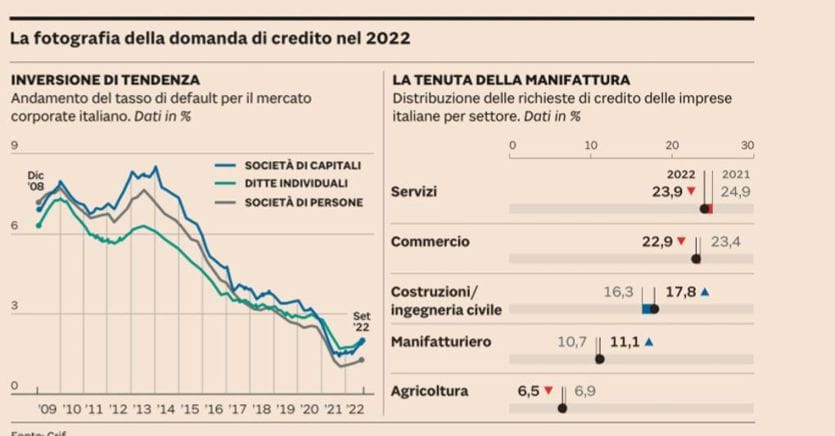It is no longer just the year-and-a-half, almost two-year long wave of unprecedented liquidity injection. The slowdown in credit applications by businesses recorded by Crif in 2022 (-5.7% compared to the previous year) begins to reflect the first signs of the uncertainty generated on the markets by geopolitical tensions, by the rise in energy prices and raw materials, with the consequent rush of inflation, and by the policy of progressively raising interest rates initiated by the central banks.
Increase the default rate
Not only that: “For the first time since 2013, the trajectory of credit risk has changed,” explains Simone Capecchi, executive director of the Bologna-based company specializing in credit information systems. Of course, this is a first slight reversal of the trend, which keeps Italy still well below the main European countries, such as Germany, but the figure is significant. «From 2013 to September 2021 the default rate, i.e. the risk that the demand for credit brings with it, had progressively and continuously decreased, falling from peaks of 7% to an all-time low of 1.5%, achieved above all thanks to the government interventions of subsidized finance to support companies in the first waves of the Covid-19 pandemic – adds Capecchi -. From September 2021, this descending line first flattened out and then started to rise again, for four subsequent quarters, until it reached an average of 2% last September”. It is too early to give a reliable interpretation of this data: we have to wait and see if this trend will consolidate in the coming quarters. Furthermore, it should be noted that default rates, in absolute values, are still low compared to the historical average and the pre-pandemic figure. However, the current macroeconomic context, characterized by an uncertain recovery and high inflation, as well as the prospect of a rise in interest rates “suggest that the dynamics underway may undergo an acceleration”, observes the analyst.
Declining credit applications
Returning to the demand for credit, Crif notes for the whole of 2022, as mentioned above, an overall drop of 5.7%, which however includes a greater resistance for large companies (-2.4%) and a decidedly more accentuated decrease for small businesses, down by 12% compared to 2021. «The demand for credit is an important element for assessing the state of health of the economy – explains Capecchi – because it is the first indicator that intercepts the behavior of an entrepreneur, in particularly his propensity to invest. This also happens for household mortgage applications, but this principle is even more true for entrepreneurs, who turn to banks to obtain money when they have a long growth perspective and positive market expectations ahead of them and therefore need to finance ideas and projects”. When these expectations cool off, a certain wait-and-see attitude prevails and this is what is happening right now according to Crif analysts.
Of course, the drop is partly motivated, as mentioned, by the fact that we come from 18 months of great availability of subsidized finance, activated by the government to support the post-pandemic recovery from Covid-19, which had strongly pushed credit applications between 2020 and 2021. The analysis of the trend of requests reveals in fact in 2022 a progressive realignment on pre-Covid levels. However, over the past year the scenario has gradually begun to change. Businesses are asking for fewer loans from banks, not so much because they have enough, but because they are postponing major investments, especially small businesses: “When the demand for credit shrinks by double digits, as happens for small businesses, it means that entrepreneurs stop in the face of uncertainty», says Capecchi again.
The trend of the sectors
Crif, on the other hand, notes an increase in the average amount requested (+16.8%), compared to 2021, equal to a value of 123,979 euros. As for the sectors, almost a quarter of the total requests (23.9%) come from the world of services, followed by the commerce sector (22.9%), both however down compared to 2021, while vice versa the sectors are gaining shares of the total construction (17.8%) and manufacturing in general (11.1%). «The data on manufacturing is very encouraging, given that ours is a transforming country – observes Capecchi -. Italy has this incredible capacity for resilience, which then leads to an increase in GDP, higher than that of Germany, and this can also be seen in the way in which our company relates to credit».
